DOTW: Sherry Cobbler
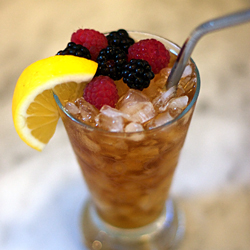 This month’s edition of Mixology Monday, hosted by Dinah and Joe at Bibulo.us, focuses on 19th century libations.
This month’s edition of Mixology Monday, hosted by Dinah and Joe at Bibulo.us, focuses on 19th century libations.
We’re no strangers to this era: Previous editions of Drink of the Week have covered the venerable Mint Julep (1824), Sazerac (1859), Martinez (1862), Manhattan (1870), Ramos Gin Fizz (1880s), Whiskey Sour (pre-1888), Widow’s Kiss (1895), and Horse’s Neck (1897). But, to a greater or lesser degree, all of these drinks have remained well-loved throughout the years.
But what of the Sherry Cobbler, the late 19th century’s most popular drink? What became of the darling that inspired such adulation?
Gin-sling, cock-tail, mint-julep, are about as vulgar as blue ruin and old tom at home; but sherry cobbler is an affair of consideration.
— “Canada and the Canadians“, Richard Henry Bonnycastle (1848)
Most sources date the origins of the Sherry Cobbler to the 1840s — the height of its popularity, to be sure. Digging through web references, I found a mention of it in Washington Irving’s Knickerbocker’s History of New York, Complete, a satirical record of early New York City, first published in 1809:
[Residents of Maryland] lay claim to be the first inventors of those recondite beverages, cock-tail, stone-fence, and sherry-cobbler, and to have discovered the gastronomical merits of terrapins, soft crabs, and canvas-back ducks.
It’s surely a tongue-in-cheek admonition, as the word “cocktail” wouldn’t have been known in the colonial era that our fictional historian details. But despite his tomfoolery, Irving thought that cobblers were sufficiently well-known in 1809 that he could reference it without description — a full 30 years before cobbler-mania’s peak.
There’s hardly a peep about cobblers until the late 1830s, but mid-century publications are chock full of evidence that Sherry Cobbler took England by storm soon thereafter. By 1844, no less a light than Charles Dickens name-checks the drink in his serial novel Martin Chuzzlewit, an otherwise scathing indictment of all things American. In one chapter, the title character’s traveling companion Mark Tapley supplies him with a restorative tipple:
He produced a very large tumbler, piled up to the brim with little blocks of clear transparent ice, through which one or two thin slices of lemon, and a golden liquid of delicious appearance, appealed from the still depths below, to the loving eye of the spectator.
‘What do you call this?’ said Martin.
But Mr. Tapley made no answer; merely plunging a reed into the mixture — which caused a pleasant commotion among the pieces of ice — and signifying by an expressive gesture that it was to be pumped up through that agency by the enraptured drinker.
Martin took the glass with an astonished look; applied his lips to the reed; and cast up his eyes once in ecstasy. He paused no more until the goblet was drained to the last drop.
‘This wonderful invention, sir,’ said Mark, tenderly patting the empty glass, ‘is called a cobbler. Sherry cobbler when you name it long; cobbler, when you name it short.
Presumably upon reading Dickens’s account of ecstasy on ice, British university students were swept up in a cobbler craze. Despite initial problems with substandard ice sourced from fishmongers, the drink’s popularity soared, finding its way into genteel parlors and private gentlemen’s clubs. By 1862, so firmly was the cobbler established that Jerry Thomas devoted an entire section of his Bartender’s Guide to different recipes for cobblers made with sherry, claret, Champagne, whiskey, and sweet wines: hock, catawba, and Sauternes. Thomas tailors ingredients to the base spirit: Often there are oranges (peel or pieces), other times pineapple; an occasional sweet liqueur joins dissolved sugar for added sweetness.
A drink that could be enjoyed by gentlefolk without incurring scorn, it’s only fitting that the cobbler would have its own trinkets. The cobbler popularized the drinking straw; before the 1888 invention of the wound-paper model, hollow reeds or even macaroni strands were used! Cobblers were also, according to some highly reputable sources, the first drinks where ingredients were shaken with ice. I haven’t been able to find primary sources to support that observation, but it’s clear that the Sherry Cobbler craze of the mid-1800s was indeed the force that propelled cocktail shakers into every bar of any size. To this day, a three-piece cocktail mixer with a built-in strainer is known as a cobbler shaker.
Unlike many antique cocktails, this one’s still quite delectable to modern palates; the fresh-fruit garnish and wine base seem downright contemporary. Rescuing this drink from near-obscurity, a new breed of bartenders are cranking up variations coast to coast.
Sherry Cobbler
3 oz medium-dry sherry (such as Oloroso or Amontillado)
1/2 oz Cointreau
1/2 oz simple syrup (or to taste)
2 lemon or orange wedges
berries or other seasonal fruit, for garnish
Squeeze one citrus wedge into an ice-filled cocktail shaker. Add the spent citrus wedge, sherry, Cointreau, and simple syrup, and shake until very cold. Strain into a cobbler glass filled with crushed ice; garnish with the remaining citrus wedge and a riot of fruit, and serve with a straw.
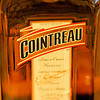
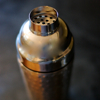
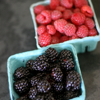
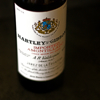
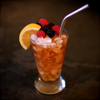




Comment by matt
man oh man I can practically taste this. It sounds like such a delicious combination.
I’d like several, thanks.
Posted on 09.15.08 at 3:56PM
Comment by cookiecrumb
How do you cobble together all this history?
Sounds divine.
Posted on 09.15.08 at 4:38PM
Comment by bb
As if the name wasn’t enough to get me to try it, you had to add a great back story. Well done!
Posted on 09.16.08 at 4:00PM
Comment by caviar and codfish
This month’s edition of Mixology Monday, hosted by Dinah and Joe at Bibulo.us, focuses on 19th century libations.
That is just too cool. 🙂
Posted on 09.18.08 at 6:45AM
Comment by EB
And who doesn’t love libations?
Posted on 09.19.08 at 8:41AM
Comment by Tartelette
Love this post!! Forwarded it to hubby the History professor who wanted to read it outloud in class. Did not quite fit with the day’s topic though 🙂
Love the cocktail!
Posted on 09.20.08 at 2:18PM
Comment by MPG
This looks so great and I love learning about the history of drinks…must get up and open my bar now 😉
Posted on 09.20.08 at 11:26PM
Comment by Lucy
This is something I will try soon, Anita. Thank you for your wonderful drink recipes. Please write a book.
Posted on 09.22.08 at 12:32AM
Comment by tiare
I join in there, you should really write a book!
Posted on 09.30.08 at 6:26AM
Comment by Garrett
Ohh, I have all this at home! Shibby. Drinks tonight are so on.
Posted on 10.01.08 at 9:23AM
Comment by Stephen Evans
Am I happy to have found this awesome, beautifully designed, written, and smart site! Next spring the topic of my Freshman Honors English class is “Americans in Paris,” and our base text is the recent, awesome anthology edited by Adam Gopnik (The New Yorker). Included is an excerpt from Mark Twain, _The Innocents Abroad_ (1869). Twain and a few gentleman American companions ferreted out a bar in Paris that purportedly specialized in the following: “All Manner of American Drinks Artistically Prepared.” It was a ruse, to say the least, as the bartender was clueless about a “whisky-straight,” then a “sherry cobbler,” and he knew nothing about a “Santa Cruz Punch,” an “Eye-Opener,” a “Stone-Fence,” or an “Earthquake.” “It was plain he was a wicked imposter,” Twain writes.
Sorry to be tedious, just hoping this might pique your interest. The reason I searched for your wonderful site was because I thought this little topic—tracing the origins of the little-known American cocktails mentioned in the reading—might be an interesting mini-research paper for some student.
Again, thank you, and salud!
Stephen Evans
Dept. of English, The University of Kansas
Posted on 10.22.11 at 5:05PM